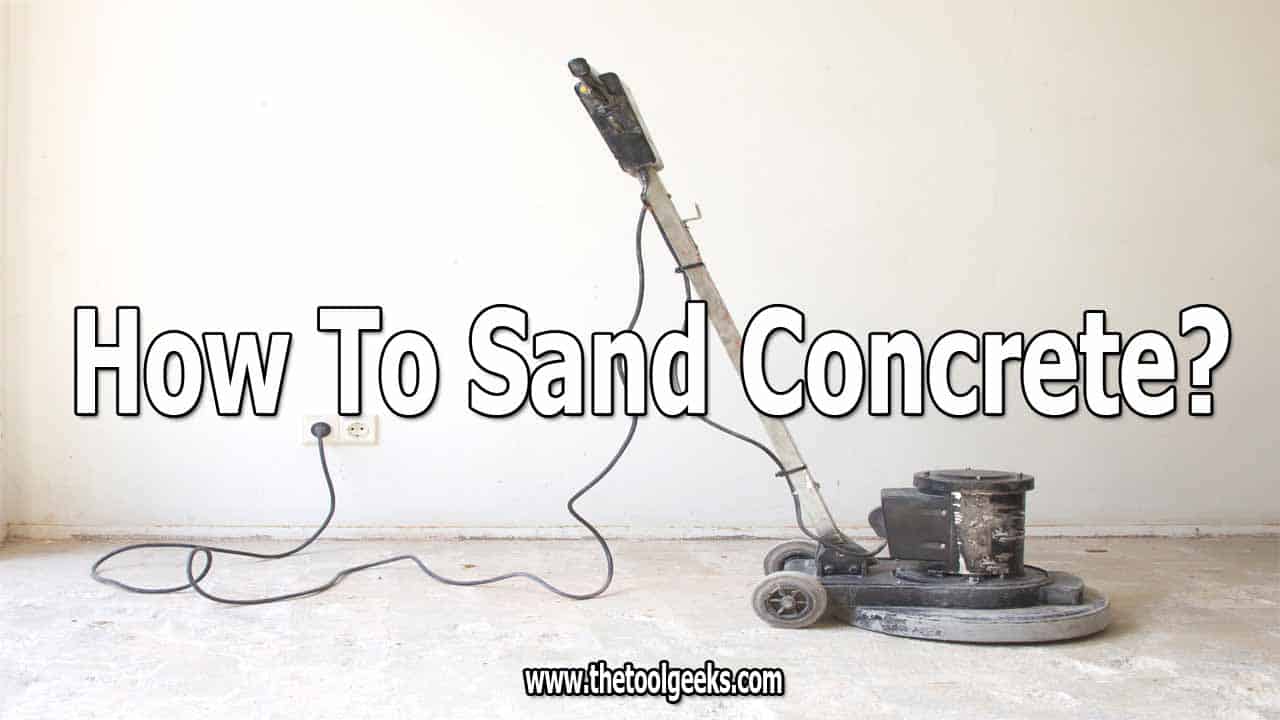How To Sand Concrete (5 Steps): Give Your Concrete Floor A New Look
TheToolGeeks.com is a participant in the Amazon Services LLC Associates Program and other affiliate advertising programs. We may earn from qualifying purchases. (Learn More).
Sanding concrete sounds like an impossible task. You might find yourself wondering how a hard stone-like surface can be sanded.
Luckily, this post will highlight not just how to sand concrete, but also the materials or tools you will need to get a well sanded concrete finish. Concrete is the most widely used man-made material for just about any building or construction project.
Concrete is used for simple house tasks like plastering and for enormous building projects like construction of bridges, dams, and skyscrapers. Portland cement (a mixture of limestone and clay), sand, water, and most times granite create the popular paste known as concrete which hardens over time.
The durability and strength of concrete make it common for building projects, especially those that are expected to last long-term.
Related Read — Best Floor SandersJump To Page Contents:
Different Types Of Concrete
Concrete is differentiated based on the materials used in preparing them, their level thickness, and their uses. The popular types of concrete include:
Plain Concrete
This is one of the most popular types of concrete paste. It is used for various light projects that do not require much strength or durability.
It is usually made with just cement, sand, and water in a specific ratio. This type of concrete is usually used for plastering walls and repairing cracks.
Related Read — Best Trim SandersCellular Concrete
This concrete type has more water than other types. It is mostly used in filling spaces. The watery nature of the concrete makes it possible for the paste to be poured in the required area, almost like you are pouring “thick water”.
It is commonly poured in foundations, floor slabs, to increase the strength of pillars, and so on. It is also self-leveling.
Reinforced Concrete
This type of concrete is usually referred to as being sedimentary. It allows the builder to add just about any material to increase its strength.
Wired mesh, steel rods, crushed rocks, granite, and so on are examples of building materials added to this concrete to make it stronger.
Asphalt Concrete
This concrete is used for the construction of surface roads, parking lots, airports, and the likes. They are made by adding asphalt while mixing concrete paste.
Precast concrete or ready-made concrete
This type of concrete is usually prepared at a different location from the site. It is brought to the site by a large vehicle and used directly. It is widely used for walls, floors, staircases, pipes, tunnels, and so on.
Other types of concrete include air-entrained concrete, self-compacting concrete, smart concrete, and so on.
You do not need to bother yourself about these types as they are hardly used for in-house projects. Countertops are the most popular concrete that people polish.
Related Read — Drywall Sanders ReviewIs It Possible To Sand Concrete?
Sanding concrete is actually an easy task as long as you make use of the right materials and tools. To sand concrete, diamond made sandpapers are used as opposed to traditional sandpapers.
Advantages of sanding concrete surfaces
Sanding automatically improves the look and finish of any floor. Sanding your concrete surface can:
- Reduce wear and tear on your concrete surface.
- Improve the lighting effect on your concrete.
- Give your surface a more expensive outlook.
- Make your surface more stain-friendly.
- Improve the durability of your concrete.
Materials needed to effectively sand concrete
To effectively sand your concrete, you need:
- Diamond sandpaper or diamond sanding pads. If you would be using a sander, you need to get quality concrete sandpaper that is suited for the sander you are using. Sandpaper for concrete surfaces is usually more aggressive than that of wood so, they can range from as coarse as 50-grit to as fine as 3000-grit depending on the strength and feel of the concrete you will be working on.
- Safety gear (gloves, mask, and the likes).
- A sander. You need a wet sander (a wet sander is configured with a hose that feeds water into the sander). If you don’t have this, it’s not a problem. Just make sure you get a source of water nearby. A bucket and a foam to soak up the water are good enough or you just get a hose that you can run directly to the tap. Both methods work as well.
- Hand pads.
- Sanding concrete can be really noisy.
How To Sand Concrete
When sanding concrete, you need to use a sander. Don’t opt for using your hands or wrap sandpaper around a brick. If you are doing that, you will need a lot of strength and time, so just use a sander.

Clean The Surface
First things first, put on your safety gear. If this isn’t your first time reading content on this blog, you probably know by now how important safety is on our posts. Put on your safety gear before you begin any task.
Then, clean your surface with a damp rag or just rinse the surface. You don’t want any unnecessary debris or material to hinder your work.
Related Read — Belt Disc Sanders ReviewApply Water To Concrete
You need to apply water on your surface. Not too much water and not too little. Just that amount that feels right. If you apply too much water accidentally, just go on with it. It’s a concrete surface so water won’t do much damage as it would on wood.
Start Sanding
Turn on your sander and start sanding. It is advisable to start with a 50-grit sanding pad if your surface is really rough or uneven.
Put your 50-grit sandpaper on the sander and start sanding. To do this, just move your sander around in a circular motion or from left to right.
Whichever direction you pick, just ensure you cover as much surface area as you can.
Learn More — How To Sand Your Staircase?Sand Tough Spots
sand continuously for about 30-60 seconds depending on what type of concrete surface you are working on. For a countertop, just sand for about 45 seconds, then clean the surface and check it out.
If you sanded it effectively, you should see a bit of exposed aggregate on your surface. When that happens, you need to decide if you want to continue sanding that spot or move on. This decision depends on the type of finish you are going for.
You need to effectively sand the tough spots. Usually, with concrete slabs, there shouldn’t be any tough crevice or corner but if you are working on a concrete surface and your sander can’t get to some areas, consider using hand pads to reach those spaces.
Finish
After sanding, rinse and clean the surface well so you can see the results. If you aren’t pleased with the result, repeat the steps again only with a more aggressive concrete sandpaper.
I highly doubt there will be uneven surfaces when using 50-grit sandpaper. This sandpaper has been known to effectively sand concrete.
Follow the steps above and you are sure to have a beautiful concrete surface after the finish. If you are working on a larger and coarser surface, you might need a bigger sander, but these steps should work well on just about any concrete surface.
The time you spend sanding might just vary based on the size and feel of your concrete.
Learn More — How To Sand Clear Coat?How To Safely Sand Concrete?
When sanding concrete, you need to be extra cautious because you are working with sharper grits, harder surfaces, and aggregate. Any of these can cause injuries if you are not careful. Here are a few safety measures for you to follow.
- Remove all fragile things and furniture from the room. Debris from the concrete can damage household objects
- Always use your safety gear. Goggles, gloves, and masks are your best pals when working on concrete.
- Ensure you are using concrete sandpapers. Normal sandpapers would not do a good job on stone. You will find yourself changing sandpapers every other minute with almost no visible evidence of work done.
- Constantly check your sander to know if it is still in good condition to continue the task.
- Always rinse and clean the concrete as you work, so you know when to stop and when to increase grit.
If you use the steps above and follow the safety precautions, you will surely have an evened out and ready to finish concrete.
If any part of this post made your task easier, make sure to leave comments and let us know. Remember sanding concrete is not as difficult as it sounds, so be sure to try it out and have a good sanding experience.
Amazon and the Amazon logo are trademarks of Amazon.com, Inc, or its affiliates.

